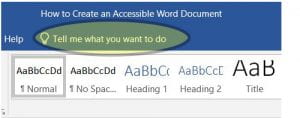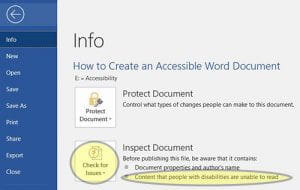Word Document Web Accessibility
Text
Sentences usually should be short. If long sentences are needed, limit them to one per paragraph.
Use headings as chapter titles on a page, so topics can be scanned by screen readers.
Use headings in order of importance. For example, a Heading 1 (H1) should appear before its sub-topic Heading 2 (H2).
Refer to information on a page by its sub-title, not location. For instance: “Examples are found in the container labeled “Samples.” Do not state: “See examples of heading sizes to the right of the page.” Desktop and mobile screens display differently. The container may not be on the right for a particular screen.
Do not leave too much blank space within a document. A screen reader can mistakenly identify a large blank area as being the end of the document.
Images
Alt-text for images should provide the same information to a screen reader as to a person with no sight impairments. For example, the alt-text for this photo reads “Rain drops cling to tree leaf buds in Johnston Rhode Island. Photo by Lydia Rogers.” Notice that the alt-text in this case describes the photo, while the caption only gives information not obvious from the photo itself: location and photographer.

Photo by Lydia Rogers
Examples of images can be photos, charts, logos, and cartoons. If text is part of an image, be sure to include that information in the alt-text. Examples of text in an image are phone numbers and slogans.
Hyperlinks
Have meaningful text hyperlinks. Screen readers can focus on links for a person with visual impairments. When looking for a link, the screen reader only looks for text that is linked, it does not read near-by words. Use phrases such as “read the movie review here,” rather than “click here.”
Inform your reader whenever clicking on a link will result in a download to the computer or phone. For example, “download the PDF of the application here.”
When possible, add screen tips that will appear when a mouse
.
Accessibility Check
Word provides checks for accessibility. If you want a PDF, you can “save as” your Word document as a PDF.

